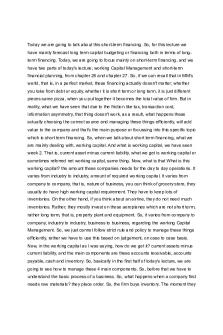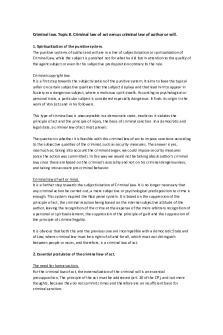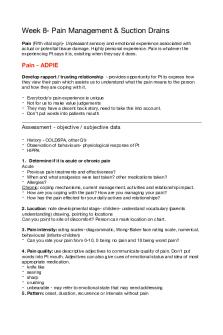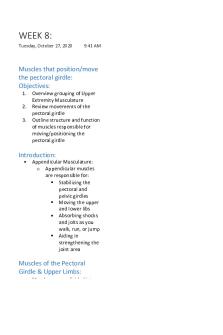Fetal Circulation - Lecture notes Lecture 8 PDF

| Title | Fetal Circulation - Lecture notes Lecture 8 |
|---|---|
| Course | Anatomy And Physiology I |
| Institution | Pace University |
| Pages | 4 |
| File Size | 66.5 KB |
| File Type | |
| Total Downloads | 41 |
| Total Views | 135 |
Summary
anatomy notes on fetal circulation...
Description
Fetal Circulation: Placenta provides an indirect connection between the mother’s body and her unborn child Umbilical Vein-carries oxygenated blood from the Placenta to the fetus Umbilical Arteries-carry deoxygenated blood from the fetus to the Placenta Umbilical blood vessels are functionally similar to the Pulmonary Circulation after birth Fetal Heart Design: o Foramen ovule: opening connecting the 2 atrial chambers; becomes the fossa ovalis after birth o Ductus Arteriosus: links the pulmonary artery and the aorta; becomes the Ligamentum Arteriosum after birth o Because of the extensive mixing of oxygenated and deoxygenated blood, this inefficiency is compensated for by the presence of Fetal Hemoglobin which combines with oxygen at a much lower oxygen tension than does adult Hb. o Ductus Venosus: is a vascular shunt in the Liver that delivers highly oxygenated umbilical venous blood to the fetal heart; becomes the Ligamentum Venosum after birth. o At birth, the foramen ovule closes, the ductus arteriosus is discontinued and the ductus venosus is converted into a fibrous cord, establishing a heart in which there is no longer the mixing of oxygenated and deoxygenated blood. Control of Blood Pressure: ***(THIS (CONTROL OF BLOOD PRESSURE) WILL BE ADDRESSED ON EXAM #2 o Neural Regulation of Heart Rate: Cardiovascular Center - in Medulla Oblongata Sympathetic Neurons: trigger the release of Norepinephrine: Increases Heart Rate Paratympanic Neurons: Vagus Nerve - triggers the release of Acetylcholine - Decreases Heart Rate o Pressure Receptors: Baroreceptors Aortic Sinus - in Aorta Carotid Sinus - in Internal Carotid Artery o Chemoreceptors: Sensitive to levels of Oxygen and Carbon dioxide Aortic Body - in Aorta Carotid Body - in Internal Carotid Artery
Hormonal Regulation: ADH - Antidiuretic Hormone- stimulates kidneys to conserve water (Vasopressin) Adrenal Medulla Hormones: Enhance Sympathetic Response epinephrine norepinephrine o Renin-Angiotensin-Aldosterone - in Kidney o
The Anatomy of Blood Vessels: blood vessels form a closed system of tubes that carry blood from the heart to all of the tissues of the body and then returns it to the heart the circuit involves the flow of blood from: o the Heart to the o Arteries to the o Arterioles to the o Capillaries - (where gas exchange with the cells takes place) to the o Venules to the o Veins- and then back to the Heart the Arteries and Veins - have the same 3 layers in their walls: o Inner Coat: Tunica Interna- composed of: endothelium basement membrane internal elastic lamina (not in veins) o Middle Coat: Tunica Media -composed of: external elastic lamina (not in veins) smooth muscle o Outer Coat: Tunica Externa - composed of: elastic and collagen fibers Capillaries - composed of: o one single endothelial layer o a basement membrane The number of capillaries will vary based on the metabolic activity of the tissue they serve The Systemic Circulation: *** There is an Artery & Vein List in the Course Information Area that you will need to learn in order to complete "Blood Tracers" for Exam 2. Practice Blood Tracers and their
Solutions are located in the Assignment Area. They are organized according to your Textbook - Chapter 21. Rules: o for each major artery carrying blood there is usually a corresponding vein o often, the artery & vein have the same name o the name can correspond to an organ or bone o The Route involves blood flow through the following path: heart aorta--> coronary arteries and to other branches thoracic aorta abdominal aorta - this terminates at the 4th lumbar vertebrae into the: common iliac arteries - to the lower extremities Once gas exchange has occurred at the level of the capillaries at the various organs, blood flows into the venules, the veins and then back to the vena cava to the heart Subdivisions of the Systemic Circulation: o Coronary Circulation-blood supplying the heart myocardium Right & Left Coronary Arteries are the first branches from the aorta Cardiac Veins- complete the coronary circulation collecting deoxygented blood from the myocardium "Angina Pectoris" : severe chest pain - a sign of inadequate blood supply to the heart; often due to a blockage (occlusion) of the coronary blood vessels Repair Methods: Coronary Artery Bypass Graft CABG Angioplasty Coronary Stent o Pulmonary Circulation-route is from the heart to the lungs and back to the heart where gas exchange takes place in the capillaries in the walls of the air sacs (alveoli) o Hepatic Portal Circulation- this circuit involves the flow of blood from the digestive and accessory organs to the LIVER BEFORE being allowed to return to the Inferior Vena Cava blood from the spleen; stomach; pancreas and intestines flows into the Hepatic Portal
Vein then to the Liver then to the hepatic vein back to the IVC...
Similar Free PDFs

8 - Lecture notes 8
- 21 Pages

8 - Lecture notes 8
- 21 Pages

Dox 8 - Lecture notes 8
- 21 Pages

Lesson 8 - Lecture notes 8
- 2 Pages

Assignment 8 - Lecture notes 8
- 4 Pages

8 Midwifery - Lecture notes 8
- 3 Pages

Taxation 8 - Lecture notes 8
- 2 Pages

Week 8 - Lecture notes 8
- 6 Pages

WEEK 8 - Lecture notes 8
- 10 Pages

CL-8 - Lecture notes 8
- 12 Pages

Tema 8 - Lecture notes 8
- 8 Pages

10/8 Lecture Notes
- 4 Pages

Colorimeter - Lecture notes 8
- 10 Pages

Lec8notes - Lecture notes 8
- 1 Pages

Pdf - Lecture notes 8
- 29 Pages
Popular Institutions
- Tinajero National High School - Annex
- Politeknik Caltex Riau
- Yokohama City University
- SGT University
- University of Al-Qadisiyah
- Divine Word College of Vigan
- Techniek College Rotterdam
- Universidade de Santiago
- Universiti Teknologi MARA Cawangan Johor Kampus Pasir Gudang
- Poltekkes Kemenkes Yogyakarta
- Baguio City National High School
- Colegio san marcos
- preparatoria uno
- Centro de Bachillerato Tecnológico Industrial y de Servicios No. 107
- Dalian Maritime University
- Quang Trung Secondary School
- Colegio Tecnológico en Informática
- Corporación Regional de Educación Superior
- Grupo CEDVA
- Dar Al Uloom University
- Centro de Estudios Preuniversitarios de la Universidad Nacional de Ingeniería
- 上智大学
- Aakash International School, Nuna Majara
- San Felipe Neri Catholic School
- Kang Chiao International School - New Taipei City
- Misamis Occidental National High School
- Institución Educativa Escuela Normal Juan Ladrilleros
- Kolehiyo ng Pantukan
- Batanes State College
- Instituto Continental
- Sekolah Menengah Kejuruan Kesehatan Kaltara (Tarakan)
- Colegio de La Inmaculada Concepcion - Cebu
